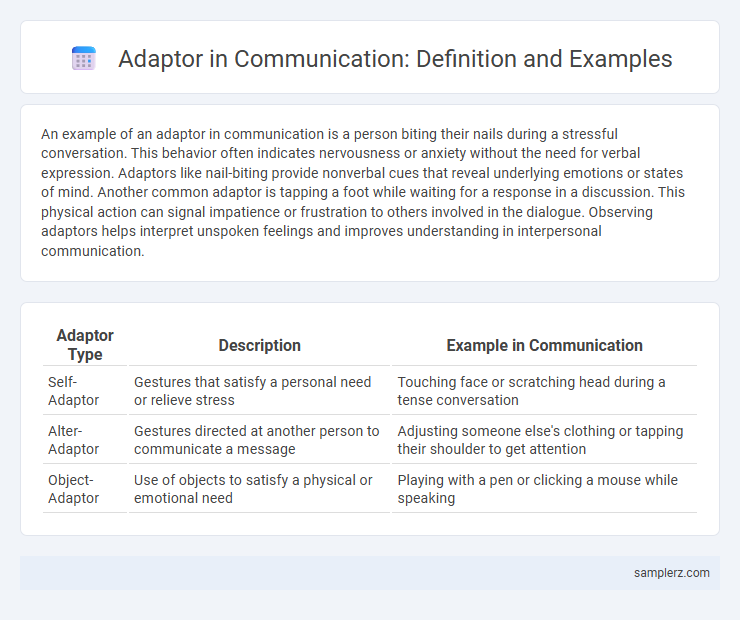An example of an adaptor in communication is a person biting their nails during a stressful conversation. This behavior often indicates nervousness or anxiety without the need for verbal expression. Adaptors like nail-biting provide nonverbal cues that reveal underlying emotions or states of mind. Another common adaptor is tapping a foot while waiting for a response in a discussion. This physical action can signal impatience or frustration to others involved in the dialogue. Observing adaptors helps interpret unspoken feelings and improves understanding in interpersonal communication.
Table of Comparison
| Adaptor Type | Description | Example in Communication |
|---|---|---|
| Self-Adaptor | Gestures that satisfy a personal need or relieve stress | Touching face or scratching head during a tense conversation |
| Alter-Adaptor | Gestures directed at another person to communicate a message | Adjusting someone else's clothing or tapping their shoulder to get attention |
| Object-Adaptor | Use of objects to satisfy a physical or emotional need | Playing with a pen or clicking a mouse while speaking |
Understanding Adaptors in Communication
Adaptors in communication are nonverbal behaviors individuals use to manage emotions or physical needs, such as fidgeting, tapping fingers, or adjusting clothing. These actions often reveal underlying feelings like anxiety, boredom, or discomfort, providing important cues in interpersonal interactions. Recognizing adaptors enhances emotional intelligence by allowing better interpretation of unspoken messages and improving communication effectiveness.
Common Types of Adaptors
Common types of adaptors in communication include self-adaptors, object-adaptors, and alter-adaptors, each reflecting different psychological states. Self-adaptors involve touching one's own body, such as scratching or fidgeting, often signaling stress or nervousness. Object-adaptors involve manipulating objects like pens or phones, while alter-adaptors are gestures directed towards others, such as adjusting a partner's clothing, indicating social connection or anxiety.
Physical Adaptors: Gestures and Movements
Physical adaptors in communication include unconscious gestures and movements such as scratching, fidgeting, or tapping fingers that signal internal states like anxiety or boredom. These nonverbal cues often reveal emotions that speakers might not verbally express, influencing the interpretation of the message. Understanding physical adaptors enhances interpersonal communication by providing insight into unspoken feelings and attitudes.
Psychological Functions of Adaptors
Adaptors in communication often manifest as subconscious gestures such as fidgeting, nail-biting, or adjusting clothing, reflecting underlying psychological states like anxiety, discomfort, or nervousness. These nonverbal cues serve to regulate internal emotional tension and provide a means for self-soothing during stressful interactions. Recognizing adaptors enhances understanding of emotional well-being and interpersonal dynamics within various communicative contexts.
Cultural Differences in Adaptor Use
Adaptors in communication, such as gestures, vary significantly across cultures, influencing how nonverbal cues are interpreted. For instance, in Japan, using fingers to point is considered rude, whereas in many Western cultures, it is a common way to indicate direction. Understanding these cultural differences in adaptor use prevents misunderstandings and enhances effective intercultural communication.
Adaptors in Professional Settings
Adaptors in professional settings include gestures like adjusting eyeglasses, tapping a pen, or repositioning a chair, which often reveal underlying stress or impatience during meetings. These nonverbal cues can implicitly communicate discomfort or anxiety without disrupting verbal communication. Recognizing such adaptors helps managers assess employee engagement and emotional states during business interactions.
Impact of Adaptors on Message Clarity
Adaptors in communication, such as fidgeting, adjusting glasses, or tapping a pen, can distract the audience and reduce message clarity by diverting attention away from the speaker's words. These nonverbal cues may convey nervousness or uncertainty, undermining the speaker's credibility and weakening the intended message. Minimizing adaptor behaviors enhances focus on verbal content, improving overall communication effectiveness.
Nonverbal Adaptors in Interpersonal Communication
Nonverbal adaptors in interpersonal communication include gestures like fidgeting, scratching, or adjusting clothing, which often signal nervousness or discomfort. These subtle behaviors help individuals cope with stress or regulate emotions during interactions. Recognizing nonverbal adaptors can enhance understanding of a person's true feelings beyond spoken words.
Adaptor Examples in Digital Communication
Adaptors in digital communication include typing pauses, screen glances, and emoji use, which help convey emotions and regulate interactions subtly. For example, a sender's delayed response time can signal hesitation or thoughtfulness, while frequent use of laughing emojis often softens the tone and builds rapport. These nonverbal cues enhance message interpretation and social bonding in virtual conversations.
Reducing Misunderstandings with Adaptors
Adaptors, such as gestures like fidgeting or touching the face, help regulate emotional tension during communication and provide nonverbal cues that clarify intent. By recognizing these subtle physical behaviors, communicators can better interpret underlying emotions and reduce misunderstandings. Effective use of adaptors allows for smoother interactions and more accurate message decoding in both personal and professional settings.

example of adaptor in communication Infographic
 samplerz.com
samplerz.com